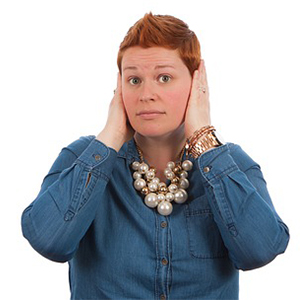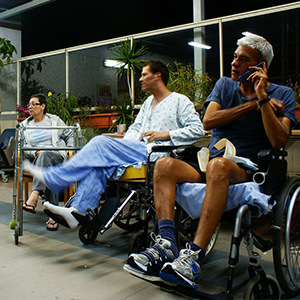Resolution of Vertigo and Restored Hearing with Chiropractic in Patient with Meniere’s Disease
The Journal of Upper Cervical Chiropractic Research published the results of a case study on May 10, 2021, documenting the case of a patient suffering from Meniere's disease who regained hearing and had a resolution of dizziness with chiropractic care.
 According to the U.S. National
Institutes of Health (NIH) National Institute on Deafness
and Other Communication Disorders, "Ménière’s disease is a
disorder of the inner ear that causes severe dizziness
(vertigo), ringing in the ears (tinnitus), hearing loss, and
a feeling of fullness or congestion in the ear. Ménière’s
disease usually affects only one ear."
According to the U.S. National
Institutes of Health (NIH) National Institute on Deafness
and Other Communication Disorders, "Ménière’s disease is a
disorder of the inner ear that causes severe dizziness
(vertigo), ringing in the ears (tinnitus), hearing loss, and
a feeling of fullness or congestion in the ear. Ménière’s
disease usually affects only one ear."
NIH continued, "Ménière’s disease can develop at any age, but it is more likely to happen to adults between 40 and 60 years of age. The National Institute on Deafness and Other Communication Disorders (NIDCD) estimates that approximately 615,000 individuals in the United States are currently diagnosed with Ménière’s disease and that 45,500 cases are newly diagnosed each year."
In this case, a 51-year-old woman sought chiropractic care for help with her Ménière’s disease with severe vertigo. Her history involved multiple instances of trauma and injury. At age 7, she had a bicycle injury where she flipped over the handlebars and landed on her face. She was involved in several car accidents and fell off a treadmill hitting her head on a concrete wall. She later developed ringing in her ears followed by intermittent hearing loss in both ears, sometimes going completely deaf.
In addition to her hearing issues, the woman also suffered from occasional migraines, allergy related sinus headaches, neck pain and stiffness, mid and lower back pain, anxiety, insomnia, chronic fatigue, digestive problems, and restless leg syndrome. She had been an active mother of three grown children, but her conditions had worsened to the point where she was currently on disability.
The woman underwent surgery in her upper spine as it was medically thought that a deformation of her upper spine was the cause of her issues. Although she did receive some relief, the surgical solution only gave her about six months of help before most of her issues returned. After this, she decided to try chiropractic.
A chiropractic examination was performed along with specific spinal x-rays, spinal thermography and relative leg length analysis. Specific forms of chiropractic adjustments were given to address the subluxations that were determined to be present.
This study reports that after the first adjustment, the patient no longer suffered with vertigo and was improved on every level. Her hearing was restored and the ringing in her ears had resolved to where she only had an occasional humming sound.
The author of this study concluded by summing up this case. "51-year-old woman suffering from Meniere’s Disease and post failed craniectomy experienced positive health outcomes following chiropractic care."
 In explaining the reason for
studying chiropractic care for stroke victims, the authors
explain, "Chiropractic care has the potential to facilitate
motor recovery in stroke survivors due to its influence on the
central nervous system. Chiropractic care constitutes a holistic
approach to health, with a focus on the identification and
correction of central segmental motor control (CSMC) problems
that chiropractors often call vertebral subluxations."
In explaining the reason for
studying chiropractic care for stroke victims, the authors
explain, "Chiropractic care has the potential to facilitate
motor recovery in stroke survivors due to its influence on the
central nervous system. Chiropractic care constitutes a holistic
approach to health, with a focus on the identification and
correction of central segmental motor control (CSMC) problems
that chiropractors often call vertebral subluxations." The benefits of breastfeeding
have been well documented. The study begins by pointing out the
importance of breastfeeding, "Significant health benefits are
not only afforded to the infant but also to their mothers in a
dose-response manner." When there is a breastfeeding problem,
the authors point out, "Breastfeeding difficulties includes a
wide range of different biological, psychological, and social
factors. For the infant, breastfeeding difficulties is
associated with failure to thrive."
The benefits of breastfeeding
have been well documented. The study begins by pointing out the
importance of breastfeeding, "Significant health benefits are
not only afforded to the infant but also to their mothers in a
dose-response manner." When there is a breastfeeding problem,
the authors point out, "Breastfeeding difficulties includes a
wide range of different biological, psychological, and social
factors. For the infant, breastfeeding difficulties is
associated with failure to thrive." This study reports that OME is
quite common affecting 90% of children some time before school
age. They estimate that there are about 2.2. million diagnoses
of OME every year in the United States, which costs the economy
$4.0 billion. The study notes that many cases of OME are missed
because there is usually no ear pain. Instead, these children
may only have hearing loss, ear fullness, or difficulty
performing in school. Typical medical treatment for OME is
surgery with insertion of ear tubes.
This study reports that OME is
quite common affecting 90% of children some time before school
age. They estimate that there are about 2.2. million diagnoses
of OME every year in the United States, which costs the economy
$4.0 billion. The study notes that many cases of OME are missed
because there is usually no ear pain. Instead, these children
may only have hearing loss, ear fullness, or difficulty
performing in school. Typical medical treatment for OME is
surgery with insertion of ear tubes.